How to adopt a child?
You can adopt a minor child whose only or both parents:
- gave consent to adoption;
- died or was declared dead by a court;
- unknown;
- declared missing by the court;
- declared incompetent by the court;
- deprived of parental rights by the court;
- for reasons recognized by the court as disrespectful, does not live with the child for more than six months and evades his upbringing and maintenance (except for cases of adoption by foreign citizens or stateless persons).
Children who are brothers and sisters cannot be raised by different people, unless they cannot be raised together.
Who is prohibited from adopting children?
Sometimes the subject in any case does not have the right to become responsible for the upbringing of a minor. The limitation of this possibility is associated with the individual characteristics of the person, physiological and mental state, material and social characteristics.
In particular, the law prohibits giving children to a person:
- incapacitated, partially capable;
- deprived of parental authority or limited in such rights;
- deprived of guardianship powers or trustee status;
- suffering from one of the diseases or disorders from the List established by Decree of the Government of the Russian Federation No. 117 of February 14, 2013 (for example, alcoholism and drug addiction, malignant tumors, mental disorders, group 1 disability);
- without sufficient income (at least one subsistence minimum per person, taking into account the number of dependents after the family is replenished);
- does not have a permanent address, except for representatives of those nationalities of the Russian Federation for whom leading a nomadic, semi-nomadic lifestyle is considered the norm;
- convicted for crimes against life, health, sexual integrity;
- convicted of serious and especially grave crimes;
- living in a same-sex marriage;
- spouses, one of whom does not have full legal capacity;
- to the former adoptive parent, who in the past did not fulfill his duties in good faith.
In addition, subjects who have not completed training - special courses at the School of Foster Parents - will not be able to become legal educators. This rule does not apply to a close relative, stepfather or stepmother who decided to replace the adopted mother or father. By the way, other concessions are allowed in relation to the listed persons, for example, regarding the area of occupied housing.
How does the adoption procedure work?
You need:
- undergo training at a school for foster parents (close relatives of the child, stepmothers and stepfathers are not required);
- obtain permission to adopt>;
- register as an adoptive parent>;
- if you don’t yet know who to adopt, pick up a child>;
- meet with the child in the presence of the guardianship authorities>;
- apply to the court for adoption>;
- register the adoption with the civil registry office>;
- if the child does not live in Russia, register him with the consulate.
General procedure for adopting a child
In order for a family to have a baby from an orphanage or baby home, you need to successfully go through several stages. The procedure is quite complicated, it involves contacting different authorities, preparing several packages of official documentation, and most importantly, establishing contact with the adoptee. The future adoptive parent will need:
- complete special courses;
- get permission;
- register with a special account;
- choose a future student;
- get to know the mentee;
- submit papers to court;
- record parental status in the registry office.
Important. If a boy or girl is taken for permanent residence outside the Russian Federation, the minor must also be registered with the consulate.
In any case, the procedure should begin by contacting the guardianship authorities, where the applicant will be provided with detailed advice and will be helped to draw up a list of necessary documentation, which is determined based on the circumstances of the particular case.
Contacting the guardianship authorities
According to paragraph 2 of Art. 125 SK, in order to adopt a child, you must first obtain a conclusion from the guardianship authority. First of all, officials will offer the applicant to undergo training at a school for foster parents. This is mandatory both for adoptive parents and for those who want to formalize guardianship or trusteeship. The average duration of the course is 50-80 academic hours, and the training itself is free.
Note. You cannot miss classes, otherwise you will have to make up for lost time with other groups.

You must then obtain permission to adopt. To do this, you need to submit an application and the required attachments to the social security department. Employees will check the applicant's living conditions. If all requirements are met, the person will be allowed to register as adoptive parents.
Child selection
If a citizen does not know who exactly he wants to accept into his family as a daughter or son, then he will be asked to familiarize himself with the regional and federal data bank.
Important. According to paragraph 2 of Art. 124 a minor who is left without parental care can be adopted. This category includes orphans, as well as boys and girls whose parents were deprived of parental rights.
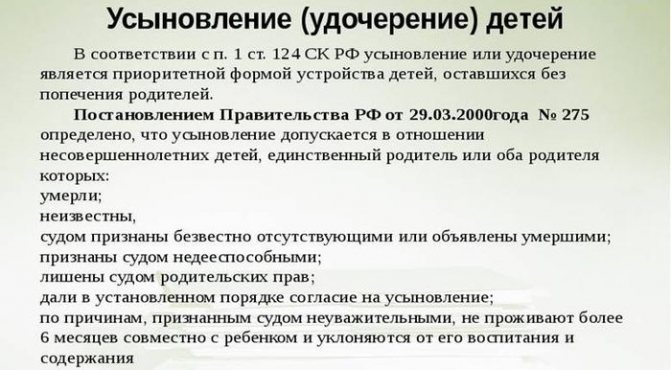
Information that can be obtained through the electronic database:
- photo of the baby;
- character traits;
- physiological characteristics, presence of diseases;
- brothers and sisters (as a general rule, adoption of brothers and sisters by different persons is not allowed);
- reasons for lack of parental attention.
After choosing a suitable candidate, the guardianship authorities issue a referral to visit the minor.
Personal acquaintance with the child
The visit referral is valid for 10 days. Extension of the period is possible only in exceptional circumstances. The meeting with the potential ward takes place in the presence of a representative of the special institution where the adoptee lives.
During the visit, it is important to establish contact with the boy or girl, since the opinion of the future pupil is also taken into account. In addition, during a visit to the orphanage, the applicant has the right to examine all the documents of the minor, as well as initiate an independent medical examination.
If the adult and the child have found a common language, you need to inform the operator of the board of trustees that the choice has been made. From this moment on, information about the orphan is removed from the data bank.
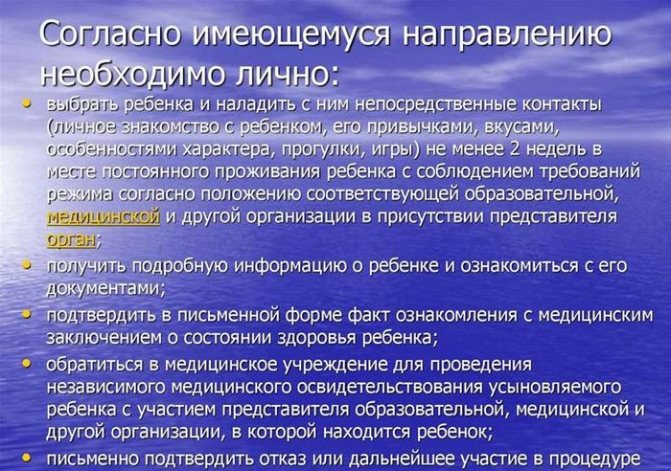
Collection and submission of documents
Collecting documents is one of the most important stages in the entire process. The duration of the procedure itself depends on the completeness of the collected documentation package.
Note. It is better to immediately take all the papers in two copies, since they will be needed both by the guardianship authority and in court.
The list of documents required for adoption consists of:
- passport of a citizen of the Russian Federation or other appropriate identification document;
- marriage certificates, consent of the spouse - only for those who are in a marital relationship;
- medical certificate (valid only for 3 months);
- income certificates;
- certificates of ownership of residential real estate, extracts from the Unified State Register of Real Estate, social tenancy agreements or rental agreements for an apartment or house;
- confirmation of completion of special training for adoptive parents;
- extracts on registration of persons wishing to adopt a minor.
Foreigners additionally submit a conclusion from the government agency of their country that they have the right to foster a minor, as well as permission for the adoptee to enter and permanently reside in the territory of a foreign state.

In addition, when applying to the court, you need to prepare a statement of claim, the content and form of which are provided for in Art. 131 Code of Civil Procedure. The court is authorized to request other documents if necessary.
Judicial review
Cases regarding the establishment of adoption are considered according to the rules of special proceedings. Such appeals are sent to the Supreme Courts of the republics, regional, regional courts or courts of federal cities, autonomous regions, autonomous districts at the place of residence of the minor.
Note. The application must be reviewed within 2 months after its submission. The form of the meeting is closed, but the presence of employees of the guardianship authority, the prosecutor's office and the child himself is required if he is over 14 years old.
Other interested parties may also take part in the legal proceedings, for example, the biological parents of the adoptee or the child himself aged 10 to 14 years.
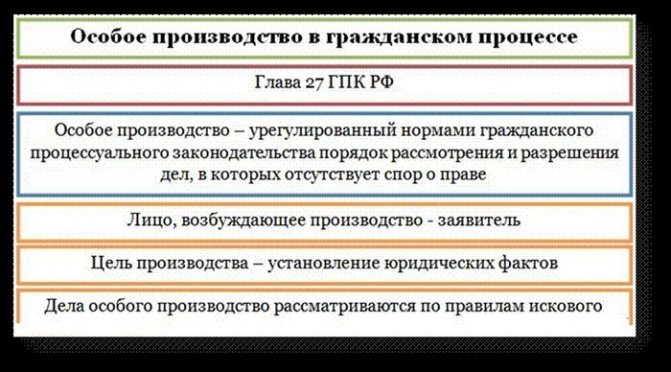
Based on the results of the consideration, the judge makes one of the possible decisions:
- grants the plaintiff's request;
- rejects the request.
Post-trial registration
After the court decision enters into legal force, the adoption is considered established. However, this fact still needs to be registered in the civil registry office. Documents can be sent to the authority located:
- within the jurisdiction of the court that made the relevant decision;
- at the place of residence of the new parents.
You need to submit an application, passport and court decision to the registry office. Employees of a government agency can make changes to an existing act record or create a new one. This depends on whether the request to change the boy's or girl's place of birth has been approved by the court, and whether ties to biological relatives will be maintained.
Important. Completion of the required registration activities is confirmed by the issuance of an adoption certificate. If the changes affect the personal data of the minor, the adoptive parents also issue a new birth certificate.
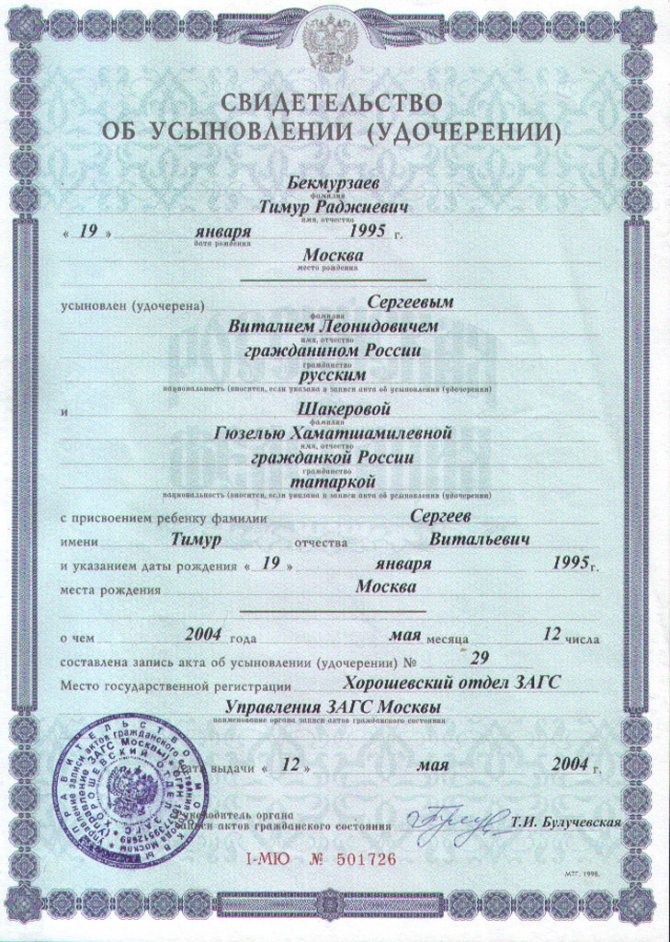
It is allowed to take the baby home after the court decision has entered into legal force. By the way, the bank operator must be informed about the act adopted by the servants of Themis within 10 days after the end of the period established for the appeal.
Search methods
There are different ways to find a child for adoption:
- through communication with familiar people who are employees of the relevant competent authorities. They can advise and provide you with information about a baby that suits your wishes;
- the child of your friends or neighbors ended up in a shelter as a result of a variety of circumstances;
- accidentally met a baby at a shelter during a holiday or charity event;
- you are constantly in contact with children's institutions where orphans live, due to work or other circumstances, and you know about all the children.

But in the vast majority of cases, adoption is painstaking work, inquiries, visiting institutions, getting acquainted with information about children. This can go on for months until you find that same baby who will become a full-fledged member of your family.
Part 1 of Article 124 of the Family Code of the Russian Federation: “Adoption is a priority form of placement for children left without parental care.”
It is worth understanding that adoption is not only your business, but also the task of the state, and specialized institutions work to carry it out. Accordingly, you can count on support and assistance. Every year, methods of searching for children are being improved, and new systems are being introduced to select them. The unified Data Bank of children left without parental care is becoming more sophisticated and of higher quality.
The Ministry of Education and Science of the Russian Federation is implementing an Internet project - “Adopt in Russia”, where you can access a constantly updated database of orphans, get all the information you need and advice from specialists. The activities of many non-governmental organizations, foundations and projects today can help find a baby.
Database
The Russian Federation has a system for collecting, storing, and systematizing data about children left without parental care, care, and education. It is called the “Children’s Data Bank” and is a source from which all the necessary information is provided to candidates for adoption who have made a corresponding request in order to find a baby.
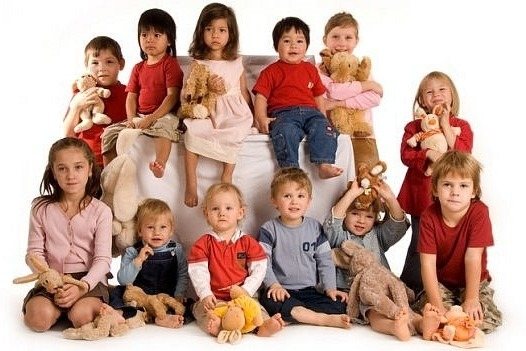
There is a special database of children up for adoption
The formation of the Bank begins at the level of districts of the constituent entities of the Russian Federation. When a child who needs placement in a new family appears on the territory entrusted to them, guardianship authorities enter all available data about him in a special questionnaire. It contains photographs, personal information, medical indications, known information about the parents, and why the baby ended up in this situation. During the first thirty days, all data about the child remains with the subordinate guardianship authority, which takes measures for his placement.
After the thirty-day period, if the child has not been properly accommodated, his case is sent to a higher authority of regional significance. Here the data is entered into the regional Data Bank. This institute is within the competence of the regional educational administration institution, manages all information and provides data upon incoming requests.
The operator and other competent structures in charge of this issue are trying by all legal means in the interests of the baby to place him in full-fledged conditions. To achieve this goal, the following measures are being taken:
- information about children is published in regional print media, special social videos are created in other media (television, radio, websites, etc.);
- Various events and social activities are held.
If, after thirty days, the child cannot be accommodated at the subject level, the package of his documentation is transferred to a federal operator.
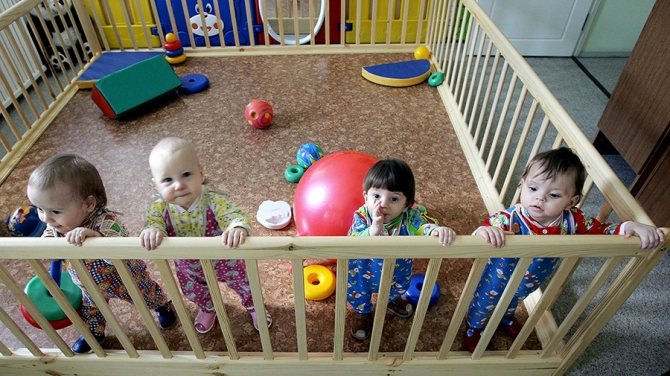
It is worth considering the fact that data about children arrives in databases with delays
Data in specialized Banks is rarely updated. This is worth considering when searching. Thus, information about babies under 12 months is updated once a year, and about children older than this age – once every three years. It is worth considering the fact that data about children enters the database with delays and therefore is often not true. This applies to the presence of diseases and other characteristics.
A multi-level system for storing and presenting data about children who need placement in a new family allows you to maximize opportunities and resolve the situation favorably for a larger number of children. The transfer of data to a higher-level authority does not imply the cessation of the activities of local guardianship authorities in placing a child; work continues at all levels.
Searching for a child through the Data Bank
Contacting the Data Bank operator implies:
- filling out an application requesting information about children meeting the specified characteristics;
- filling out a special form (this paper is needed to enter the candidate adoptive parents’ data into a special database).
After providing such information, the competent employee is obliged to provide the data at his disposal that meets the parameters of the request. The presence of automated systems allows you to provide information about children on the day of application. In case of technical or other complications, data must be provided no later than ten days from the date of submission of the application.
If at this moment there are no children meeting the specified parameters, the candidate leaves all the necessary data. As soon as a suitable child appears, the potential adoptive parent is notified. In accordance with legislative norms, the candidate for adoptive parents is required to be informed monthly about the state of affairs, the appearance of new children or the absence thereof
Visiting a child
If the adoption initiator has found a suitable option among the candidates provided, he is issued a referral to visit the social, educational, or medical institution where the child is located. A visit document can only be issued to one candidate at a time in order to avoid two applicants visiting the baby at the same time.
When visiting an institution, the initiator is required to provide a personal file, a medical card, and all other available information. Employees must talk about the character, developmental characteristics, and life of the child. If, after meeting your child, you feel that he is not suitable for you, you must fill out the appropriate paper about the results of the visit for the Bank operator and submit a new application so that data on other children can be provided.
The law does not limit the number of possible applications and issued visit permits. The initiator of the placement of the baby has the right to continue the search until a suitable boy or girl is selected.
Selection may be suspended if, after the candidate has been informed (mandatory monthly notification) about the availability of children, he has not familiarized himself with this data. After repeated notification (a month later), if there is no response from the initiator, the search is terminated. In order to resume the selection, the potential adoptive parent must again contact the Data Bank with an application and provide the required documentation.

Contacting the guardianship authority at your place of residence is another way to find a child for adoption.
Visiting orphanages
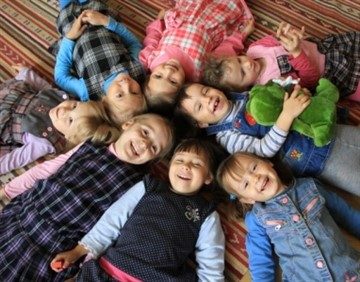
Children from an orphanage for adoption are the most common option.
Information about children from the orphanage can be found in the official database.
The database for adoptive parents opens after the guardianship authorities have issued a positive conclusion.
This database contains children who are waiting for adoption, their photographs, brief information, and the status of children in orphanages throughout the country. As soon as you have found a suitable child, you need to contact the local guardianship authority and get permission to meet him, without which you will not be allowed into the orphanage.
The permit is valid for ten days. On these days, you will need to meet with the child and get acquainted with his personal file and medical record. The orphanage staff will talk about the character and life of the baby. If, after visiting the child, you feel that he is not suitable for you, you need to fill out the appropriate paper about the results of the meeting, and you can start the search again.
The number of permits to visit the orphanage is not limited, so the search for children for adoption can continue until suitable boys or girls are found for adoption.
Other search methods
Another way to search is to contact the guardianship authority at your place of residence with a request to help select a child. After submitting the appropriate application and providing the necessary information, specialists from the guardianship authority will make requests to regional and federal databases. After receiving questionnaires for suitable children, the candidate for adoptive parents will be informed about this and called for review and selection.
But you should understand that this method is much more time-consuming. Every person planning an adoption needs to know that the conclusion on the right to be an adoptive parent and other documents are valid for twelve months, and the conclusion on medical indications is only ninety days. If the selection of a candidate is delayed, there will be a need to update papers and certificates.
In addition to contacting database operators, the possibility of searching through institutions whose competence includes the maintenance and upbringing of children who find themselves in a situation without the care of relatives and friends is not prohibited. Most of these institutions are under the authority of executive authorities regulating education issues. These include:
- preschool orphanages - here children are accommodated after being discharged from the infant home and up to the age of 7;
- orphanages or boarding schools - children who have reached school age are defined here. They attend a nearby secondary school. In a boarding school, children study directly in an institution where all the necessary conditions for receiving an education are created;
- specialized and correctional educational institutions - children with disabilities and difficulties of a medical, mental and social nature live and study here;
- institutions providing medical services for children who are deprived of parental education and care. Such institutions include baby homes and maternity centers.
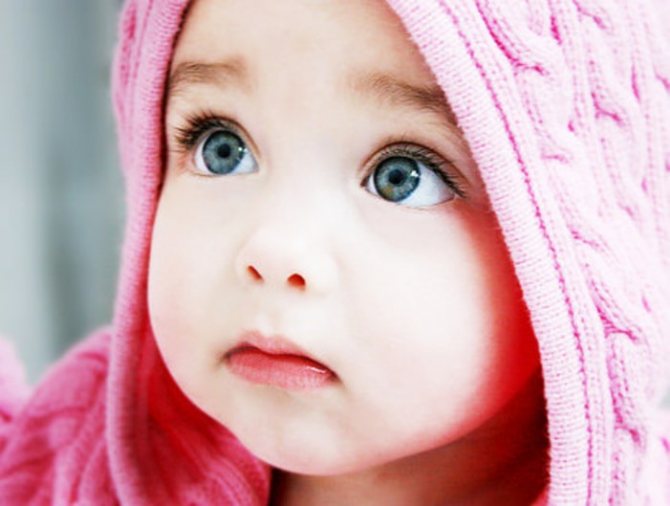
Adoption procedure
This process is quite complex and lengthy. It is necessary to clarify all the nuances of the procedure with the local guardianship and trusteeship authority in advance so as not to waste time correcting mistakes.
A number of certificates that need to be collected have expiration dates, so if the process is delayed, it becomes necessary to re-issue these documents.
The procedure is as follows:
- Contact your local child welfare office. The institution will need to write a statement of intent to become adoptive parents and attach the necessary documents to it.
- Obtain a conclusion from the guardianship authority. If the issue is resolved positively, a conclusion will be issued on the possibility of becoming adoptive parents of an adopted child. The decision of officials is influenced by the potential parent’s compliance with the requirements established by law and the presence of a sincere and conscious desire to accept a child into their family.
- Get acquainted with the existing bank for orphans. All children who end up in orphanages (refuseniks from maternity hospitals, children of parents deprived of their rights, etc.) are entered into the regional and federal databases. Therefore, future adoptive parents can look at candidates not only in their region, but throughout the country.
- Agree with the selected orphanage on the possibility of making a visit to meet the prospective adoptive child.
- If a positive decision is made regarding the child, prepare documents and a statement for the court.
- Go to court to obtain a decision on adoption (or refusal if there are grounds).
- After the court decision enters into force, obtain an adoption certificate from the registry office based on it.
List of documents
Required documents:
- passport>;
- marriage certificate (if available);
- information about income (certificate of employment, tax return);
- characteristics from work>;
- documents confirming ownership of housing>;
- a copy of the personal account confirming the absence of debt on utility bills;
- conclusion of the sanitary service on the state of living conditions;
- certificate of good conduct>;
- medical report>;
- autobiography.
Requirements for parents
The parents of a child from an orphanage can be adult, capable citizens, married or unmarried. Marital status is not a criterion for evaluating candidates.
Reasons why the opportunity to adopt a child may be denied:
- incapacity (physical, mental);
- low income>;
- lack of permanent housing>;
- outstanding criminal record>;
- alcohol, drug addiction>;
- criminal prosecution for crimes against life, health, public interests;
- lack of special training allowing one to acquire skills in handling children and resolving difficult situations in the process of upbringing (does not apply to close relatives or current parents);
- presence of facts of deprivation of parental rights , deviation from guardianship and trusteeship, deprivation of the status of an adoptive parent (by court);
- being in a same-sex marriage.
Special requirements
Due to the fact that there are young children under 3 years old in orphanages, candidates for potential adoptive parents are considered especially carefully. Older children are able to express their own opinions about future parents and show disagreement. Children are deprived of this opportunity. Also, in case of dishonest performance by the adoptive parents of their parental responsibilities towards the child, it is extremely difficult to establish this fact, since the child himself, due to his age, cannot tell anything.
Guardianship specialists pay special attention to the psychological and moral character of candidates, and to their absence of bad habits.
Future parents should be aware of all the difficulties that they may encounter after welcoming a young child into their family.
Jurisdiction
Where to contact?
After talking with the chosen child for a sufficient time, potential parents decide whether they are ready to finally take the baby into the family.
If the decision is made, you need to move on to the next stage of the procedure - judicial. To do this, you need to write an application to the court.
The jurisdiction of adoptive parents is determined by Article 269 of the Code of Civil Procedure of the Russian Federation according to their status:
- Russian citizens must apply to the district or city court at the location of the orphanage;
- a foreigner or living abroad is sent to the court of the subject of the Federation where the ward is located.
What is needed for a claim?
To open proceedings, two copies of documents are submitted to the court, duplicating the papers when first applying to the PLO:
- application for adoption of a child from an orphanage into the family;
- documents confirming the identity and legality of a civil marriage;
- conclusions about the state of health, income, living conditions;
- certificates from the guardianship regarding appropriate preparation and the possibility of adoption.
If the adoptive parent is not a citizen of the Russian Federation
Then, in addition to the presented list of documents, it provides additionally:
- consent of the child’s representative for adoption;
- conclusion of the authorized body of the state in which he resides on the possibility of being a guardian;
- permission to enter the country and permanently reside in it for the pupil;
- consent to the arrival of guardianship in order to monitor the fulfillment of requirements in relation to the pupil;
- consent to mandatory registration at the Russian consulate.
Important! All documents submitted by foreign citizens to the court must first be translated into Russian and notarized.
Proof
Article 55 of the Code of Civil Procedure requires that court actions be based on evidence.
The evidence taken into account should be information from candidates for trustees and PLOs confirming that the decision to place the pupil in a family is made in his interests.
If there is insufficient evidence, the judge may require the PIO to clarify or provide additional information.
Drawing up an application
The submitted document must indicate the data required by Article 270 of the Code of Civil Procedure. The form itself must correspond to the established one and be submitted in two copies, handwritten or printed. It must indicate :
- personal data of the trustees and the pupil, including place of residence;
- confirmed information about the pupil’s family and the circumstances under which he was placed in the orphanage;
- requests: for adoption, for changing the pupil’s full name and information about his birth, for registering adoptive parents as the child’s parents;
- evidence of the possibility of adoption.
It is possible to submit a joint application from spouses who agree to adopt the child.
Deadlines
In accordance with the law (Article 154 of the Code of Civil Procedure), the period for consideration of the case is up to 60 days. During this time, the decision to place the baby in the family must either be accepted or rejected. A loyal judge will try to make a decision as quickly as possible.
Since the participation of the prosecutor in the decision-making is mandatory, the hearing date is set on the day of his presence in the civil court. As a rule, a decision is made within three weeks. At the court hearing, the decision made will be announced, and if it is positive, the adoptive parent will be issued a decree on the transfer of rights to the pupil.
After five days, the resolution will be fully formalized, this is prescribed by Article 199 of the Code of Civil Procedure. As a rule, the decision takes effect after ten days (unless the protest is implemented).
Early execution of the resolution is possible if the adoptive parents believe that delay will cause harm to the health or morale of the ward. This situation is provided for in Article 212.
Final stage
The final stage of the adoption procedure should be the registration of a new family member in the registry office at the place of residence. The basis for issuing the relevant documents will be a copy of the court decision sent there by the bailiff.
State duty and other expenses
Tax legislation does not provide for the payment of state duties when establishing guardianship (Article 333.36 of the Tax Code of the Russian Federation). Litigation does not require hiring an attorney or lawyer unless there are special circumstances in the case. In a situation of lack of time, a lawyer can help at the stage of preparing papers for the PLO and the court.
In the case of adoption of a child by a non-Russian citizen, having a lawyer may be useful, especially if he has extensive experience in handling such cases. Before hiring a lawyer or lawyer, you should make sure that he or she has the appropriate license.
Gender and age of the child for adoption or guardianship
When choosing a gender, it is worth remembering that finding a boy is a little easier than finding a girl in the state guardianship authorities, there are no exact explanations for this, it’s just how it happened historically. It is worth remembering that children develop more slowly in the system, and therefore there is no need to set clear age limits. It is likely that a four year old will look like a three year old. It is best to keep in mind the age of the baby, but do not refuse to meet older or younger children.
If it was decided to take a preschooler into the family, then he needs time to adapt. If you take a six-year-old child in August and send him to school in September, problems will arise, both for the parents and for the child himself. Therefore, it is necessary to take time into account and give the child the opportunity to adapt. Ideally, you need to leave the child at home for a year, and let the guardians not be afraid that the child will go to first grade a year later, this is much easier than an unadapted child in the family, and even at school it is necessary to adapt.
Newborns and infants
Many people want to become adoptive parents of a newborn child, and this is understandable. Nowadays, many couples decide to simulate pregnancy, when the woman wears a false belly, which increases along with the duration of the “pregnancy,” and meanwhile there is an intensive search for a baby for adoption. The child will not necessarily be straight from the maternity hospital; perhaps by the time of adoption he will already be one or two months old, but such babies can easily be passed off as newborns.
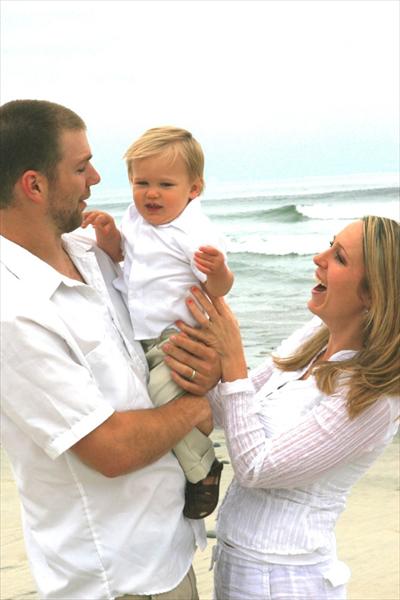
The advantage of adopting a baby is that the child is in the family from the first days of life. A young mother can experience all the delights of maternity leave - diapers, baby vests, bottle feeding, daily walks with a stroller. A strong emotional connection is formed between the child and parents. But the concerns of adoptive parents about an infant child are also completely justified. It is difficult to assess appearance - in just a year the child can change a lot; it is impossible to assess the baby’s intelligence and character. Subsequently, serious diseases may be identified, since some congenital hereditary pathologies do not appear immediately.
Children from one to three years old
This age period is attractive for adoption for many reasons. It is easier for parents to choose a child of the desired appearance, similar to one of the adoptive parents. You can already assess the character - the child is either quiet and shy, preferring quiet games, or an active toddler who does not sit still for a minute. Children at this age begin to talk, they are inquisitive and active, open to communication, copy the behavior of their elders, which evokes universal affection and love from adults. On the health side, there is less fear that any disease will manifest itself over time.
At the same time, we should not forget that the baby managed to experience a feeling of loneliness and lack of attention in the orphanage, which is why many experience delayed mental development. Adaptation after adoption can be complicated due to the additional influence of the age crisis of two or three years. In this case, you just need to be patient and pay more attention to the joyful moments of family life.
Children from three to five years old
At this age, children are quite independent; they eat, dress, wash and brush their teeth themselves. When adopting a child of this age, parents don’t have to worry about their work, they don’t need to take parental leave, and after the baby settles into the family, he can start going to kindergarten. Children aged 3-5 years are less likely to suffer from infectious diseases than children aged one to three years.
From five to seven years
A child of this age has a mature character and has his own habits. Children develop the concept of family, they want to have parents, so the child tries very hard to please the future parents. Adaptation after adoption is relatively easy, since the child himself is interested in joining the family, he especially needs the love and affection that he lacked. It is easier to assess a child’s mental abilities and his preferences in creativity. Healthy children of preschool age rarely suffer from colds; the adopted child will attend preschool and gradually prepare to enter school. Adoptive parents should understand that at this age it will be difficult to keep the adoption secret.
From seven to ten years
By this age, a child’s character is almost completely formed, his mental and creative abilities are revealed. Future parents who decide to take a schoolchild into their family must understand that this is a fairly old child and it will not be possible to re-educate him completely according to their standards and preferences. You need to appreciate the individuality of the child as a person and only correct him in the right direction.
Teenagers
Adolescence is the most problematic age for parents. Adults should be understanding of children’s protests and insubordination; they should try to become a friend to the child and communicate with him as an equal, as with an adult. The child usually understands and appreciates that the adoptive parents accept him into their family in order to help him realize himself in life and provide the necessary emotional support. Before adopting a teenager, a fairly long period of preliminary acquaintance is required, and consent from the child himself to adoption is also required.
As we can see, there is no ideal age for adoption , and you should not adhere to strict limits in choosing the gender and age of the child. Perhaps, when you receive a referral for a 3-month-old baby boy, it may happen that you cannot pass by a cute two-year-old girl, and she will become your favorite daughter. Every adoption story is unique.
Requirements for an adoptive parent
The legislator has established a number of requirements for persons who want to replace the closest people to little orphans or street children. At the same time, the emergence of the right to adoption is not related to whether the applicant is in a registered marital relationship. Although, in practice, officials often give preference to married couples, citing the fact that in such a family the child will feel more comfortable.
But according to the Family Code, the conditions under which single men, women or married couples are allowed to take a child from an orphanage are almost the same.
| Compliance criterion | Single man or woman | Married couple | Relative, stepfather or stepmother |
| Age | Adults, the difference from the adoptee is at least 16 years | Adults, age difference may be reduced | |
| Health | Satisfactory state of health, absence of diseases specified in Decree of the Government of the Russian Federation No. 117 of February 14, 2013 | Relief may be allowed for those who are already associated with a minor in the common life | |
| Income level | Sufficient to support oneself, existing dependents and the adoptee (at least one child subsistence level per child) | Relief may be allowed for those who are already associated with a minor in the common life | |
| Housing conditions | Availability of a registered place of residence, sufficient living space for all family members. It is ideal to allocate a separate room for the person being adopted; it is inadmissible for children of different sexes to live in the same room. | It is necessary to confirm your registration, however, relaxations may be allowed regarding the square footage of the occupied home | |
| Preparation | Completion of training at the school of foster parents | No special training required | |
| Additional permissions | Not required | If only one of the couple is adopting, the other must give consent | If a stepfather or stepmother is adopting, you need permission from your spouse (mom or dad) |
| The right to adopt jointly with another subject | Not provided | Allowed | Allowed for subjects in marital relationships |
Preliminary custody

Guardianship is the definition of minor children left without parental care.
The guardian only represents the interests of the child. Under guardianship, the child retains his first and last name, and the guardian does not have the rights of a parent.
But adoption is another form of child placement. A child enters a family as a child. Preliminary guardianship is usually issued in emergency cases upon presentation of a passport and application.
This form of guardianship is most often chosen as an interim form of guardianship before adoption. This is due to the fact that the adoption procedure takes a long time. And so that the child goes straight to the family, and not to an orphanage. Priority is given to relatives.
How to take a baby from the maternity hospital?

The process looks like this: first, the adoptive parent must submit an application and take a position in the queue for the child , and then contact the ROO.
And further actions completely coincide with the standard procedure.
Child status
There are two types of status for a child in orphanages. Some kids can be taken under any form of guardianship - adoption, foster care, guardianship, etc., while other kids can only be taken under guardianship. If you decide to immediately adopt a child, you need to look for a child with full status.
But there is another side to the coin; there are situations when the child practically has a status, but for its realization it is necessary to wait some time. In fact, this is far from a bad situation, because it is possible to take the child under guardianship “to get used to each other,” and only then adopt.
A child may not have full status for several reasons, for example, the child’s parents are in prison, in which case deprivation of parental rights is not possible. The child’s parents may be given a restriction of rights based on “behavior”; such a restriction is imposed for six months, and after this time the issue of either depriving them of their rights completely or returning the child to the family is decided.
Status may also be absent due to mental disorders in the child’s parents. It is possible to completely deprive such parents of parental rights only if their incapacity is recognized and a guardian is appointed. But, on the other hand, such parents will not be able to take the child. The calmest option is considered to be the absence of the necessary time - six months, which must pass after the parents are deprived of their rights. This option does not require any additional procedures.
Medical examination of a child
For each child, a report on the state of his health is submitted to the guardianship authority. But each candidate for adoptive parents has the right to their own medical examination of the child.
Children subject to adoption are examined under certain conditions:

- the examination must be carried out in licensed medical institutions;
- the medical worker of the institution from which the child is required to be present;
- The examination period should not exceed 30 days.
The nuances of receiving a daughter or son from a wife/husband
This process differs somewhat from a typical adoption procedure in that it is not possible to renounce parental rights in the future.
In order for a stepfather to have the right to adopt, his companion must have the status of a single mother, this is possible under the following circumstances:
- The child is born within 300 days after the divorce.
- Paternity has not been established.
- The child was adopted by an unmarried woman.
Attention! If the child has a legal father, as confirmed by an examination, then his consent to the adoption procedure will have to be obtained.
Child's relatives
It is necessary to immediately discuss the attitude towards the child’s blood relatives, most often these are grandmothers, aunts, etc. if the child is immediately adopted, then this issue does not need to be discussed, since there is a secret of adoption, the relatives simply will not know which family he is in child.
But if the child is under guardianship or in a foster family, then relatives have the right to communicate. As practice shows, most often this remains at the level of desire, or it can be phone calls to make sure that everything is okay with the child.
If communication with the child’s relatives causes harm to the child, then guardians or adoptive parents have the right to limit this communication by obtaining the opinion of a psychologist and writing an appropriate statement.
The child’s consent to register his adoptive parents as parents
In general, taking into account the opinion of the adoptee regarding the adoption procedure, as well as the entry of the adoptive parents as the parents of the adopted child in the book, is mandatory if at the time of the adoption of the relevant court decision the child has reached the age of 10. However, there is one exception here: if the child, even before submitting the corresponding application, lived for a long time with the adoptive parents (or adoptive parent), and perceives them (him) as his (his) parents (i.e., when the child, for example, does not knows that he lives in a foster family), then such consent from the adoptee may not be taken even from a child over 10 years old - this norm allows you to save the child from unnecessary worries and psychological trauma.
Separately, it is worth mentioning that the regulations do not establish any specific form, a unified sample document in which such consent should be expressed. It is generally accepted that the child’s consent must be expressed in free written form. In addition, the legislation establishes that the guardianship and trusteeship authorities, monitoring the peculiarities of the life of the adoptive family and the stay of the adoptee in it, can reveal the consent of the child to his adoption by those people with whom he lives (or will live), which must be reflected in in a separate document or written additionally in the conclusion of the authority about how reasonable and appropriate the interests and characteristics of the child will be adoption.
At the same time, it would be advisable to remember that the law states that such consent must be necessarily attached to the above-mentioned application. Therefore, taking into account this norm and the above, the guardianship authorities must prepare the specified act along with the child’s unambiguous consent to adoption by specific people, with the signature of the child himself (provided he reaches the age of ten).
It is necessary to remind once again that the actions of law enforcement agencies, guardianship and trusteeship authorities, and adopting citizens must be aimed at observing all the rights and freedoms of the adopted child. If adults act carefully and legally thoughtful, the legal consequences of adoption will have a positive outcome for all parties.
Author of the article
Appearance of a child for adoption or guardianship
This question will be relevant only after 2 years, newborn babies can change dramatically by the age of one year, turning from blond to brunette or vice versa. Only the eye color remains unchanged after six months of a child’s life. If it has been decided to maintain a conditional secret, and the adoptive parents are afraid of the questions: “Who is your baby like?”, then it is worth remembering that genetics is a mysterious “thing.” With a clear conscience we can say that the child looks like his grandfather, grandmother, etc. Even children from mixed-race parents can have a completely Slavic appearance and vice versa.
How to find biological parents
If the registry office refuses, you can go to court. The court decides to release specific information to the applicant. Every child has the right to live and be raised in a family, as far as possible, the right to KNOW his parents, the right to their care, the right to live together with them, except in cases where this is contrary to his interests. And the international convention on the rights of the child says the same. Russian legislators have been discussing this issue in recent years. World experience suggests that the secrecy of adoption does more harm than good. In the United States, there are organizations of adopted people who fight for the right to information about their biological parents. The Evan B. Donaldson Adoption Institute conducted a study of the law and the impact of changes to determine whether adult adoptees should have access to documents about their origin. The conclusion of the study is that yes, laws should be changed so that adoptees have this right. One of the results of this study was that where these changes in the law were adopted, there was no subsequent problem behavior of adoptees or harm to biological parents.
In July 2009, the “Rossiyskaya Gazeta” discussed the secret of adoption, in particular, the opinion of Elena Mizulina, chairman of the State Duma Committee on Family, Women and Children, was cited: “I believe that criminal liability for disclosing the secret of adoption should be abolished. ... Most members of our committee believe that at least criminal liability should be removed, and we are preparing such proposals. But this does not mean that the official who prepares documents for adoption can disclose this information. This information must be protected in the same way as privacy.”
The criteria are clear
After realizing and understanding what kind of child the family wants to adopt - gender, age, external qualities. It is necessary to start searching for the baby. First of all, the guardianship authorities will offer to get to know the children who are in the guardianship area. But if there are no suitable children in the area of residence, or there are simply no child care facilities, then in the future you need to start searching on your own. And here, there is a direct proportionality: the more effort and time spent searching for the baby, the more successful the result will be.
You should not start with telephone calls to the guardianship authorities; the ideal and correct option is to collect all documents and opinions. And as soon as they appear in the guardianship authorities, you can storm the telephone lines.
If a family wants to accept a newborn baby into their family, then there is no point in calling the guardianship authorities. Information about such children arrives three months later, or even later, after refusal - that’s the system. The ideal and correct option is to obtain information about which medical institution the refuseniks are admitted to. Visit all wards on whose territory there are hospitals with incoming refuseniks and register everywhere. Some regions do not release babies from hospitals, but wait until they are transferred to orphanages, and in such institutions it is also necessary to register.
If it was decided to adopt a non-newborn baby, then immediately after receiving the conclusion, you must make an appointment with the regional guardianship authorities. Upon arrival on the reception day, you must provide all documents and a statement of desire to familiarize yourself with the profiles of the children assigned to the territory of guardianship. If there are babies that potential parents are interested in, you need to get a referral to meet the child.
Adopted child: commentary from a school psychologist
. Mastakova E.I., psychologist of the pro-gymnasium 1733 . I studied in the 4th grade. We lived next to a forest, so we often went there with a friend. One day in the forest we met many children walking. They were dressed ridiculously, many had caked snot on their noses, and some were a little strange, unlike ordinary children. One girl had dark skin, which especially attracted our attention then. We didn’t immediately realize that these were children from the orphanage. We felt very sorry for them. We got closer and tried to get to know some of the kids. They were glad to see us. They began to approach, obsessively trying to cuddle, hold hands, talk, attract attention. A feeling of disgust arose inside, but pity overpowered it. We began to often go to that clearing to meet the guys. They bought them gingerbread and other sweets. The teachers didn't pay much attention to us. They were mostly busy communicating with each other and making sure that the children did not wander off into the forest.
Already when this boy appeared at the door - quite tall, strong; black hair; dark eyes shooting at me with apprehension, but mostly looking at the floor - my spine went cold. As always, I invited him to sit down at the table to play and complete various interesting tasks. His fingers were constantly in motion, like those of a professional sharper, all the time as if stroking and fingering the objects on the table. He didn’t look me in the eyes, but when he occasionally raised his heavy gaze to me, I froze to the chair.
We recommend reading: Spouse’s Consent to Purchase Real Estate Why It’s Necessary
Studying questionnaires of children for adoption or guardianship
The questionnaire and the child himself are in the vast majority of cases different. Even a photo of a child may not correspond to reality, sometimes even the diagnoses in the questionnaire do not correspond to the truth, so you should be more careful in your choice and check everything yourself. To make the task easier, you can focus on the child’s health group: group 1 – absolutely healthy, groups 2 – 3, children with mild treatable pathologies, group 4 – the presence of chronic diseases, and children with health group 5 have disabilities. Only the attending physician has accurate information about the child’s health status, and the diagnoses written in the questionnaire are transmitted after the next medical examination, and the human factor should not be excluded.
From all of the above it follows: if you like the child, but there are concerns about his health, then it is best to take a referral and get acquainted with his medical history in detail, on an individual basis, thereby eliminating all possible mistakes.
Conversation with guardianship
Initially, you need to familiarize yourself with the child’s personal file and find out at what age the child entered the institution, who his biological parents are, the results of the latest medical examinations, the presence of possible relatives, etc. Again, you should trust only those personal data that are documented.
After studying the questionnaire, before meeting the baby, the child care facility gives potential parents the opportunity to study the child’s medical record, and they will not hide the baby’s diagnoses from the parents, rather the opposite!
The ideal option is the help of a doctor who will help decipher incomprehensible medical terms, abbreviations, etc. It would not be superfluous to study “typical diagnoses of children in the system.”
A consultation with the pediatrician assigned to the children's institution is necessary; it is necessary to find out what the main diagnosis is, what studies were carried out and what the results are over time. Potential parents have every right to an independent medical examination of the child.
It is worth remembering that children in the system lag behind their peers raised in the family, and this, in most cases, is not a developmental delay, but simply neglect of the child. It’s just that kids don’t have enough parental attention, and there’s no one to try for!
Payments for adoptive parents
After completing the documentation of adoption, a citizen has the right to apply for the accrual of the same social payments that are due to biological fathers or mothers. The list of possible financial assistance includes:
- benefits in connection with pregnancy and childbirth - when adopting a baby under 3 months of age;
- one-time charges when transferring a minor to a family;
- monthly benefits for the period of caring for the baby until he reaches 1.5 years;
- funds from maternity capital (now also allocated for the firstborn).
Special types of financial support may also be allocated at the regional level.










